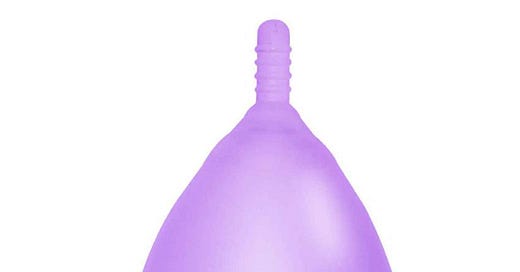Why I Called Tampons a Scam
If you have never considered using one, please investigate menstrual cups.
Edit: As I said in my video also, I am aware that for some women, tampons are the best option. Just to be clear
————
I was asked to elaborate on why I see tampons as a scam and a waste of money that represents a physical, medical threat to your womanhood, in response to a comment I made during my Dylan Mulvaney’s Tampax in a T-pot video.
The major danger of tampon usage is a condition called Toxic Shock Syndrome which is caused by the bacteria Staphylococcus aureas. This bacteria is ubiquitous (30% chance you have some in your nose and 20% chance you have some on your skin right now, causing no problem). It is frequently methicillin-resistant (otherwise known as MRSA - Methicillin-resistant Staphylococcus aureas). On your body, it’s not going to randomly cause a problem, but if you have a cut, or some sort of abscess, or the warm moist vaginal space, it can lead to overgrowth/infection which can lead to TSS from toxins produced by the Staph bacteria. Via lesions, it may also enter the bloodstream, causing sepsis. After such an infection, if you survive, you may have scarring that leads to pain, loss of sexual function, infertility, and pelvic inflammatory disease
A healthy vagina has a good bacterial microbiota kept in check through the regulatory action of the vaginal mucosa, which makes it more difficult for bad bacterial infections to take hold. This works by keeping pH low (acidic) which is why women need to regularly replace underwear as the fabric gets eaten away by the discharge. However, this regulatory action may not penetrate into a tampon, especially the super-absorbent ones most associated with TSS. Tampons have a high surface area to volume ratio, due to being composed of many different fibers that are expanding in a wet, moist environment. The bacteria can happily be growing on the surface area and multiplying until the population hits a critical mass (quorum sensing) resulting in sudden production of toxins. The bacteria will get onto the tampon during the insertion process from either your fingers or external genitalia, or possibly during manufacturing process, as staph can live on surfaces (fomites) for 24 hours or longer, or possibly from Dylan Mulvaney’s fingers handling it in secret and then repackaging it for the thrill of it.
In my opinion, a safer alternative is a silicon diva cup which has a very low surface area to volume ratio and lower potential therefore for causing TSS. There are a handful of cases in the literature, including this one from 2015, reported as the first such case, of TSS associated with a menstrual cup. The woman, 37, was new to using the menstrual cup and had caused an abrasion during insertion. She also had an underlying immune disorder. Here is another case from 2020. In contrast, up to 1 in 100,000 tampon users are estimated to get TSS annually. Since TSS is caused by the staph bacteria, anyone can develop TSS via other causes, but half of TSS cases are estimated to be associated with female tampon use. The other half are associated with other things like cuts, bites, and other sources of infections (i.e. surgeries) generally unrelated to menstruation.
To use a menstrual cup, after washing your hands (or wearing clean gloves) and cleaning your external anatomy only, you squish the cup then fold it again and insert it and it pops open inside you once you put it in far enough It’s again important to be gentle during insertion, wash your hands or wear gloves, clean your external anatomy (which may contain bacteria), and use an appropriate size cup. If you drop the cup, do not reinsert it until it has been washed. Recommendations vary by manufacturer, but it’s generally recommended to empty and wash your menstrual cup every 8-12 hours, or less depending on flow, meaning you can sleep with it.
To remove, pinch and then pull, still being gentle. If you need to (if a seal somehow gets created), pinch and tilt until it comes out freely without force. It should not hurt to insert or remove. When it is full, after removing it, you dump it out and then wash it thoroughly with soap and water prior to reinsertion (unless your menses have ended for that month). A silicone cup can be boiled to sanitize and reused for many years.
Signs it is time to replace your menstrual cup include damage to the cup, loss of flexibility of the cup, significant change in color or texture, or other indications it is old or degrading. Medical-grade silicone menstrual cups cost between $15-$30. This is the brand I used, which has never sent me money or free product, and got one purchase from me 15 years ago. Hope this was helpful!




I'm well past the menopause ( I'm 75 ) and I never used internal sanitary protection in my life ,but if I did I would now be boycotting Tampax after their stupid ,cowardly virtue signalling decision to use Dylan Mulvaney ,a man ,to advertise their products.!! Women need to wake up here and see this for what it is. Keep speaking the truth ,Exulansic. We're with you👍❤️x
Weirdly yes, I was just thinking about the fibres on my tampon this morning 🤔 must be a sign hehe
Thank you Ex, I'll definitely have a look and see if I can get this brand or something similar.
I've also been considering removing my arm implant because of your videos on messing with hormones. I'm wondering if I should have it if it's not completely necessary. Thank you, again. X